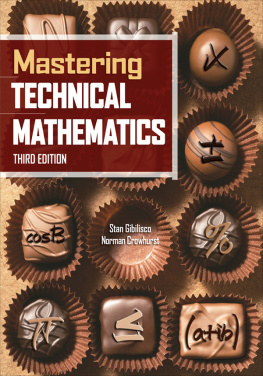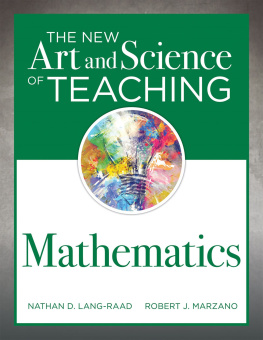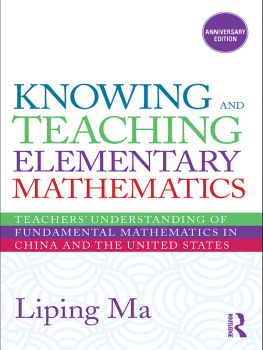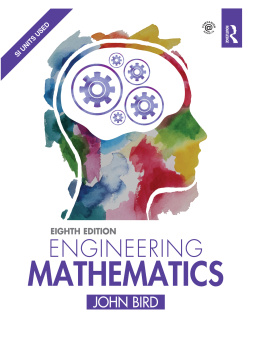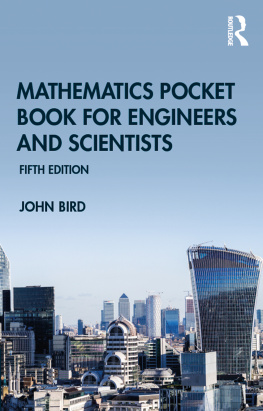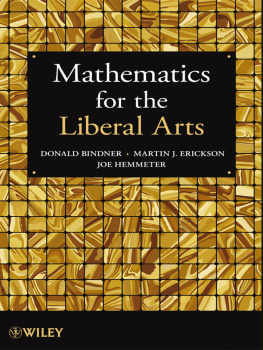Mastering Technical Mathematics
ABOUT THE AUTHORS
Stan Gibilisco is one of McGraw-Hill's most prolific and popular authors. His clear, reader-friendly writing style makes his books accessible to a wide audience, and his experience as an electronics engineer, researcher, and mathematician makes him an ideal editor for reference books and tutorials. Stan has authored several titles for the McGraw-Hill Demystified library of home-schooling and self-teaching volumes, along with more than 30 other books and dozens of magazine articles. His work has been published in several languages. Booklist named his McGraw-Hill Encyclopedia of Personal Computing one of the Best References of 1996, and named his Encyclopedia of Electronics one of the Best References of the 1980s.
Norman Crowhurst (deceased) originated the concept of Mastering Technical Mathematics. He authored the first edition.
Mastering Technical Mathematics
Third Edition
Stan Gibilisco
Norman Crowhurst
Copyright 2008 by The McGraw-Hill Companies, Inc. All rights reserved. Except as permitted under the United States Copyright Act of 1976, no part of this publication may be reproduced or distributed in any form or by any means, or stored in a database or retrieval system, without the prior written permission of the publisher.
ISBN: 978-0-07-159542-1
MHID: 0-07-149448-0
The material in this eBook also appears in the print version of this title: ISBN 978-0-07-149448-9, MHID 0-07-149448-0.
All trademarks are trademarks of their respective owners. Rather than put a trademark symbol after every occurrence of a trademarked name, we use names in an editorial fashion only, and to the benefit of the trademark owner, with no intention of infringement of the trademark. Where such designations appear in this book, they have been printed with initial caps.
McGraw-Hill eBooks are available at special quantity discounts to use as premiums and sales promotions, or for use in corporate training programs. To contact a representative please e-mail us at .
TERMS OF USE
This is a copyrighted work and The McGraw-Hill Companies, Inc. (McGraw-Hill) and its licensors reserve all rights in and to the work. Use of this work is subject to these terms. Except as permitted under the Copyright Act of 1976 and the right to store and retrieve one copy of the work, you may not decompile, disassemble, reverse engineer, reproduce, modify, create derivative works based upon, transmit, distribute, disseminate, sell, publish or sublicense the work or any part of it without McGraw-Hills prior consent. You may use the work for your own noncommercial and personal use; any other use of the work is strictly prohibited. Your right to use the work may be terminated if you fail to comply with these terms.
THE WORK IS PROVIDED AS IS. McGRAW-HILL AND ITS LICENSORS MAKE NO GUARANTEES OR WARRANTIES AS TO THE ACCURACY, ADEQUACY OR COMPLETENESS OF OR RESULTS TO BE OBTAINED FROM USING THE WORK, INCLUDING ANY INFORMATION THAT CAN BE ACCESSED THROUGH THE WORK VIA HYPERLINK OR OTHERWISE, AND EXPRESSLY DISCLAIM ANY WARRANTY, EXPRESS OR IMPLIED, INCLUDING BUT NOT LIMITED TO IMPLIED WARRANTIES OF MERCHANTABILITY OR FITNESS FOR A PARTICULAR PURPOSE. McGraw-Hill and its licensors do not warrant or guarantee that the functions contained in the work will meet your requirements or that its operation will be uninterrupted or error free. Neither McGraw-Hill nor its licensors shall be liable to you or anyone else for any inaccuracy, error or omission, regardless of cause, in the work or for any damages resulting therefrom. McGraw-Hill has no responsibility for the content of any information accessed through the work. Under no circumstances shall McGraw-Hill and/or its licensors be liable for any indirect, incidental, special, punitive, consequential or similar damages that result from the use of or inability to use the work, even if any of them has been advised of the possibility of such damages. This limitation of liability shall apply to any claim or cause whatsoever whether such claim or cause arises in contract, tort or otherwise.
To Tim, Samuel, and Tony
Contents
Introduction
This book is intended as a refresher course for scientists, engineers, and technicians. It begins with a review of basic calculation techniques and progresses through intermediate topics in applied mathematics. This edition contains new or revised material on scientific notation, geometry, trigonometry, vectors, coordinate systems, logarithms, exponential functions, propositional logic, truth tables, statistics, and probability.
Youll notice that some of the discussions, especially in the early chapters, deal with archaic units such as feet and pounds. This isnt sheer madness or nostalgia for the olden days; there is a reason for it! The unfamiliarity (and in some cases strangeness) of these English units can help you more fully grasp the principles relating the phenomena the units describe.
Ideally, youll have worked with all the material youll see in this book, or at least seen it in some form. If something here is alien to youfor example, propositional logicconsider taking a formal course on that subject, using this book as a supplement. What if you took logic from your Alma Mater 20 years ago? Are the concepts still in your mind but no longer fresh? In that sort of situation, this book can bring things back into focus, so you can again work easily with concepts you learned long ago.
Each chapter ends with a Questions and Problems section. Refer to the text when solving these problems. Answers are in an appendix at the back of the book. In some cases, descriptions of the problem-solving processes are given in the answer key. Of course, many problems can be solved in more than one way. If you get the right answer by a method that differs from the scheme in the answer key, you might have found a better way!
In recent years, electronic calculators have rendered much of the material in this book academic. To find the sine of an angle, for example, you can punch it up on a calculator you bought at a grocery store and get an answer accurate to 10 significant figures. Personal computers have calculator programs that can go to many more digits than that. Nevertheless, its helpful to understand the theory involved. You should at least read (if not painstakingly study) every chapter in this book.
Most people are strong in certain areas of mathematics and weak in others. If your job involves the use of math, youll need proficiency in some fields more than in others. When you use this book as a refresher course, keep in mind that you might need intensive work on subjects that you dont like or that you have trouble grasping.
The material here is presented in a condensed format. Youll sometimes think that your progress must be measured in hours per page. If you get stuck someplace, skip ahead, work on something else for awhile, and then come back to the trouble spot. Of course, you can always refer to more basic or subject-intensive texts to reinforce your knowledge in those areas where you are not confident.
Suggestions for future editions are welcome.
Stan Gibilisco
| 1 | From Counting to Addition |
Weve all seen or heard people count. You put a number of things in a group, move them to another group one at a time, and count as you go. One, two, three We learn to save time when counting by making up groups. shows four different ways in which seven items, in this case coins, can be grouped.

